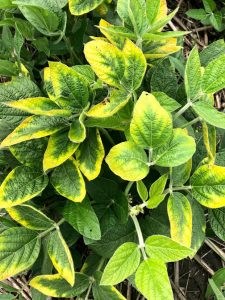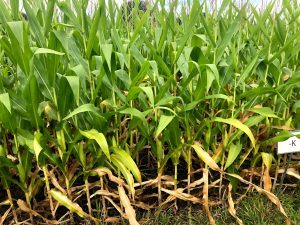Nutrient basics
Amber Anderson
- Compare and contrast macro vs micronutrients
- Relate mobility in plant to expected deficiency symptom location
- Identify potential deficiency patterns on the plant or in the field
Macronutrients vs Micronutrients
While both macro and micronutrients are required for plant growth, there are needed in differing quantities. Macronutrients are needed in larger quantities and are usually involved in the structural components of plants. Micronutrients are just as required for healthy plant growth but needed in smaller quantities. They are usually components of enzymes or metabolic functions. A micronutrient deficiency may be corrected with a few pounds per acre, while a significant macronutrient deficiency will likely take significantly more fertilizer.
Deficiency symptoms vs hidden hunger

A plant may not appear clearly nutrient deficient immediately, but may grow or yield poorly. Deficiency symptoms likely indicate a significant issue that should be addressed, but it may be too late to obtain the full yield of an annual crop this season. Deficiency symptoms can include a variety of visual abnormalities, including yellow striping, stunted plants, purple coloration, malformed structures, or others depending upon the plant and nutrient.
Deficiency vs Toxicity
Both too much and too little of a nutrient can significantly impact plant growth. At excessive levels, too much of a nutrient accumulating in tissues can cause damage, or interfering with uptake of other nutrients. This can be more significant of an issue at low pH values, when metals are more soluble.
Mobile vs Immobile

A nutrient can be mobile in the plant and the soil. If a nutrient is immobile in the plant, it can’t be moved to new growth if the plant runs out, where as a mobile nutrient couple be transported within the plant to the area of most need. Therefore, a mobile nutrient deficiency will appear in the older growth, where an immobile nutrient deficiency will first appear in the new growth. If a nutrient is immobile in the soil, a root needs to grow to it rather than relying on water to help carry it to the root. Therefore an immobile nutrient deficiency may occur in conditions of poor root growth, such as a cool, wet Midwest US spring.
Remember:
Don’t assume that a nutrient deficiency means a soil deficiency. Sometimes soil or plant conditions simply don’t allow for sufficient uptake, like iron in a high pH soil. Iron chlorosis is not effectively solved by adding more iron. Depending upon the plant or conditions, management options could include foliar application, adjusting the pH, or simply choosing a more tolerant crop.
What to look for in the field
Patterns can be helpful in determining or narrowing out potential diagnoses. A strip of yellow corn across a field or deficiency symptoms matching the width of the application equipment could be associated with equipment malfunction. Straight lines are unusual in nature, so could point to a human interaction, such as nutrient or chemical application equipment, change in plant hybrid selected, or past fenceline/treatment change.
Alternatively, an area on a steep slope showing a deficiency may be associated with erosion and resulting lower organic matter, significantly different pH value (as is common across calcareous parent materials like in the central US), or some other soil factor. Using the soil map and further soil testing can help problem solving, and may result in multiple issues being discovered.
- Nutrients have a variety of properties that influence when and where a deficiency may appear along with how much may be needed to address the deficiency.
- Challenging soil conditions may limit options for addressing the plant nutrient needs.

